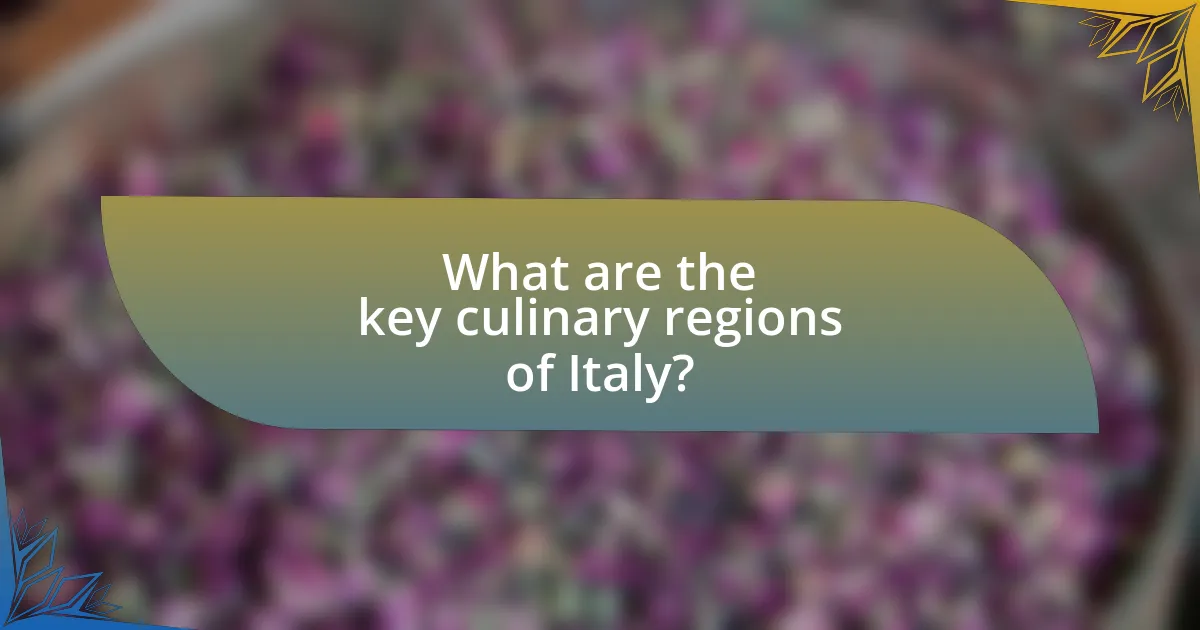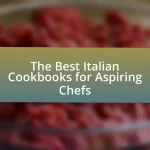The article “Exploring Italy’s Culinary Regions: A Tour Through Flavors” provides an in-depth examination of Italy’s diverse culinary landscape, highlighting key regions such as Tuscany, Emilia-Romagna, Campania, Lombardy, and Sicily. It discusses how regional ingredients and climate variations shape local cuisines, including signature dishes and unique flavors that define Northern and Southern Italian cooking. The article also explores the impact of local farming practices, food culture, and family traditions on regional recipes, as well as the importance of festivals celebrating culinary specialties. Additionally, it offers practical tips for travelers to authentically experience Italy’s food scene through cooking classes, food tours, and visits to local markets.

What are the key culinary regions of Italy?
The key culinary regions of Italy are Tuscany, Emilia-Romagna, Campania, Lombardy, and Sicily. Tuscany is known for its rustic dishes and use of local ingredients, while Emilia-Romagna is famous for its rich pasta and cured meats, such as Parmigiano-Reggiano and prosciutto. Campania is celebrated for its pizza and fresh seafood, particularly in Naples. Lombardy offers hearty risottos and polentas, and Sicily is recognized for its diverse flavors, including sweet and savory dishes influenced by various cultures. Each region’s unique culinary traditions reflect its history, geography, and local produce, making them integral to Italy’s gastronomic identity.
How do regional ingredients influence Italian cuisine?
Regional ingredients significantly influence Italian cuisine by shaping the flavors, techniques, and dishes unique to each area. For instance, the use of fresh seafood in coastal regions like Liguria leads to dishes such as pesto and focaccia, while the mountainous regions like Trentino-Alto Adige incorporate hearty ingredients like speck and polenta. This diversity is rooted in Italy’s geography and climate, which dictate what can be grown or sourced locally. Historical trade routes and cultural exchanges further enhance this variety, as seen in the incorporation of spices and ingredients from different regions over centuries. Thus, the distinct culinary identity of Italian cuisine is a direct reflection of its regional ingredients.
What are the signature ingredients of Northern Italy?
The signature ingredients of Northern Italy include rice, polenta, butter, and a variety of cheeses such as Gorgonzola and Grana Padano. Rice, particularly Arborio, is essential for risottos, while polenta serves as a staple dish. Butter is preferred over olive oil in many recipes, reflecting the region’s dairy farming traditions. Cheeses like Gorgonzola, a blue cheese, and Grana Padano, a hard cheese, are integral to Northern Italian cuisine, often used in sauces and as toppings. These ingredients highlight the region’s agricultural diversity and culinary heritage.
Which unique flavors define Southern Italian cooking?
Southern Italian cooking is defined by unique flavors such as robust tomatoes, fresh basil, garlic, and olive oil. These ingredients reflect the region’s Mediterranean climate and agricultural practices, where sun-ripened tomatoes and fragrant herbs are staples. The use of seafood, particularly in coastal areas, adds a distinct brininess, while the incorporation of regional cheeses like mozzarella di bufala enhances the richness of dishes. Historical influences, including Arab and Greek culinary traditions, further contribute to the complexity of flavors, making Southern Italian cuisine vibrant and diverse.
What traditional dishes represent each region?
Italy’s culinary regions are represented by distinct traditional dishes. For example, in the northern region of Lombardy, Risotto alla Milanese is a signature dish, characterized by its creamy texture and saffron flavor. In the Veneto region, Cicchetti, small snacks or side dishes, are popular, often enjoyed with wine. Moving to Emilia-Romagna, Tortellini, a stuffed pasta, is a hallmark dish, showcasing the region’s rich culinary heritage. In Tuscany, Ribollita, a hearty vegetable soup, reflects the region’s rustic cooking style. The southern region of Campania is famous for its Neapolitan pizza, recognized globally for its thin crust and fresh ingredients. Lastly, in Sicily, Arancini, fried rice balls filled with various ingredients, highlight the island’s diverse flavors. Each dish not only represents its region but also embodies the local ingredients and culinary traditions, making them integral to Italy’s gastronomic identity.
How do pasta varieties differ across Italy’s regions?
Pasta varieties differ significantly across Italy’s regions due to local ingredients, traditions, and culinary practices. For instance, in Northern Italy, particularly in regions like Emilia-Romagna, fresh egg pasta such as tagliatelle and tortellini is prevalent, reflecting the area’s rich agricultural heritage. In contrast, Southern Italy, especially in regions like Campania and Sicily, favors dried pasta shapes like spaghetti and bucatini, often made from durum wheat, which is well-suited to the climate and soil conditions. Additionally, specific regional dishes highlight these differences; for example, the Ligurian trofie is traditionally paired with pesto, while the Neapolitan ragù is served with ziti. These variations illustrate how geography and culture shape pasta production and consumption across Italy.
What role does seafood play in coastal regions’ cuisines?
Seafood is a fundamental component of coastal regions’ cuisines, serving as a primary source of protein and flavor. In Italy, for example, coastal areas like Sicily and Liguria incorporate fresh fish, shellfish, and other marine ingredients into traditional dishes, reflecting local fishing practices and cultural heritage. The Mediterranean diet, which emphasizes seafood, is recognized for its health benefits, including lower risks of heart disease and improved longevity. This reliance on seafood not only shapes the culinary identity of coastal regions but also supports local economies through fishing and tourism.
How does Italy’s geography shape its culinary diversity?
Italy’s geography significantly shapes its culinary diversity by creating distinct regional climates and landscapes that influence local agricultural practices and food traditions. The country’s varied topography, including mountains, plains, and coastlines, allows for a wide range of ingredients, from the seafood of coastal regions like Liguria to the rich grains and meats found in the plains of Lombardy. Additionally, the Mediterranean climate in southern Italy supports the growth of olives, citrus fruits, and tomatoes, which are staples in Italian cuisine. Historical trade routes and cultural exchanges further enriched regional dishes, leading to a unique culinary identity in each area, such as the use of spices in Sicilian cuisine due to Arab influence.
What impact do mountains and coastlines have on food production?
Mountains and coastlines significantly influence food production by affecting climate, soil types, and agricultural practices. The presence of mountains can create microclimates that either enhance or limit agricultural potential; for instance, higher altitudes may lead to cooler temperatures, which can restrict the types of crops that can be grown, while also providing irrigation through snowmelt. Conversely, coastlines contribute to a milder climate and can support diverse crops due to the moderating effects of oceanic winds and humidity. Additionally, coastal regions often benefit from fertile soils enriched by sediment deposits from rivers, enhancing agricultural productivity. In Italy, these geographical features shape the cultivation of specific crops, such as olives and grapes in coastal areas, while mountainous regions may focus on hardier crops like potatoes and grains.
How do climate variations affect regional agriculture?
Climate variations significantly impact regional agriculture by influencing crop yields, planting schedules, and the types of crops that can be cultivated. For instance, in Italy, variations in temperature and precipitation patterns can lead to changes in the growing seasons, affecting the production of key agricultural products such as grapes, olives, and tomatoes. Research indicates that warmer temperatures can enhance the ripening of grapes, potentially improving wine quality, while excessive heat or drought can reduce yields of staple crops. Additionally, regions like Tuscany and Sicily may experience shifts in their agricultural viability due to climate change, as certain crops may become less suitable for cultivation in their traditional areas.
What are the implications of local farming practices on cuisine?
Local farming practices significantly influence cuisine by determining the availability, quality, and variety of ingredients used in cooking. In Italy, for example, the use of traditional farming methods, such as crop rotation and organic farming, enhances the flavor and nutritional value of local produce, which in turn shapes regional dishes. The Mediterranean climate allows for the cultivation of diverse crops, such as tomatoes, olives, and herbs, which are staples in Italian cuisine. Furthermore, local farming supports seasonal eating, encouraging chefs to create dishes that reflect the freshest ingredients available, thereby preserving culinary traditions and promoting sustainability. This connection between farming and cuisine not only enriches the culinary landscape but also fosters a sense of community and cultural identity among the regions.
Why is food culture important in Italian society?
Food culture is important in Italian society because it serves as a vital expression of regional identity and community bonding. In Italy, culinary traditions are deeply rooted in history, with each region showcasing unique ingredients and recipes that reflect local customs and agricultural practices. For instance, the use of specific herbs and vegetables in dishes like Caprese salad from Campania highlights the region’s agricultural heritage. Additionally, communal meals, such as Sunday family gatherings centered around pasta, reinforce social ties and cultural continuity. This emphasis on food as a means of connection and identity is further evidenced by Italy’s recognition of traditional food practices by UNESCO as part of the Intangible Cultural Heritage of Humanity.
How do family traditions influence regional recipes?
Family traditions significantly influence regional recipes by preserving unique cooking methods and ingredients that reflect local culture and history. In Italy, for instance, each region has distinct culinary practices shaped by the traditions passed down through generations, such as the use of specific herbs, cheeses, and pasta types. These practices often stem from historical factors, such as the availability of local produce and the influence of neighboring cultures, which further solidify the connection between family heritage and regional cuisine. For example, the use of saffron in Risotto alla Milanese in Lombardy showcases how local ingredients and family recipes intertwine to create a dish emblematic of the region’s identity.
What festivals celebrate regional culinary specialties?
Festivals that celebrate regional culinary specialties in Italy include the Sagra del Tartufo in Umbria, which highlights truffles, and the Festa della Porchetta in Ariccia, dedicated to roasted pork. These festivals showcase local ingredients and traditional cooking methods, attracting visitors who seek authentic culinary experiences. For instance, the Sagra del Tartufo has been celebrated for over 50 years, emphasizing the importance of truffles in Umbrian cuisine, while the Festa della Porchetta has roots in ancient Roman traditions, reflecting the cultural significance of this dish in the region.
What are the best ways to experience Italy’s culinary regions?
The best ways to experience Italy’s culinary regions include participating in local food tours, taking cooking classes, and visiting regional markets. Food tours provide guided experiences that highlight traditional dishes and local specialties, allowing participants to taste authentic cuisine while learning about its cultural significance. Cooking classes offer hands-on opportunities to prepare regional dishes under the guidance of local chefs, enhancing understanding of culinary techniques and ingredients unique to each area. Additionally, visiting regional markets allows individuals to engage with local producers, sample fresh ingredients, and discover seasonal offerings, further immersing them in the culinary landscape of Italy.
How can travelers explore Italy’s food scene authentically?
Travelers can explore Italy’s food scene authentically by participating in local cooking classes and food tours that emphasize regional specialties. Engaging with local chefs and artisans allows travelers to learn traditional cooking techniques and the cultural significance of various dishes. For instance, in Bologna, travelers can take a pasta-making class to understand the art of crafting tagliatelle, a staple of the region. Additionally, visiting local markets, such as Mercato di Testaccio in Rome, provides insight into fresh ingredients and local culinary practices. This hands-on approach not only enhances the travel experience but also fosters a deeper appreciation for Italy’s diverse culinary heritage.
What are the must-try dishes in each region?
Italy’s culinary regions each feature must-try dishes that reflect their unique flavors and traditions. In the North, Risotto alla Milanese from Lombardy is essential, showcasing saffron-infused rice. In the Northeast, Cicchetti from Veneto offers small plates perfect for sharing, highlighting local ingredients. The Central region boasts Pasta all’Amatriciana from Lazio, a classic dish made with guanciale, tomatoes, and pecorino cheese. In the South, Neapolitan Pizza from Campania is iconic, known for its thin crust and fresh toppings. Sicily is famous for Arancini, rice balls filled with ragù, while the Apulia region is known for Orecchiette con Cime di Rapa, a pasta dish with turnip tops. Each dish represents the local culture and culinary heritage, making them essential for anyone exploring Italy’s diverse gastronomy.
How can cooking classes enhance the culinary experience?
Cooking classes can enhance the culinary experience by providing hands-on learning opportunities that deepen participants’ understanding of cooking techniques and regional ingredients. These classes often focus on traditional recipes and methods specific to Italy’s diverse culinary regions, allowing participants to engage directly with the culture and history behind the dishes. For instance, a study by the Italian Culinary Institute found that participants in cooking classes reported a 70% increase in their appreciation for Italian cuisine, as they learned about the significance of local produce and cooking styles. This immersive experience fosters a greater connection to the food, enriching the overall culinary journey.
What tips can enhance a culinary tour of Italy?
To enhance a culinary tour of Italy, travelers should prioritize local experiences, such as dining at family-owned trattorias and participating in cooking classes. Engaging with local chefs and artisans provides authentic insights into regional cuisines, which vary significantly across Italy. For instance, in Emilia-Romagna, known for its rich pasta dishes, joining a pasta-making workshop can deepen understanding of traditional techniques. Additionally, exploring local markets, like Mercato di Testaccio in Rome, allows visitors to sample fresh ingredients and regional specialties, reinforcing the connection to Italian culinary culture.
How to choose the best local restaurants and markets?
To choose the best local restaurants and markets, prioritize establishments that emphasize fresh, locally sourced ingredients and have strong community ties. Research online reviews and ratings on platforms like TripAdvisor or Yelp, focusing on feedback regarding food quality, authenticity, and service. Additionally, consider visiting markets that feature regional specialties, as these often reflect the culinary traditions of the area. For instance, in Italy, markets such as Mercato di Testaccio in Rome are renowned for their variety of local produce and artisanal products, showcasing the region’s flavors.
What are the benefits of guided food tours in Italy?
Guided food tours in Italy offer several benefits, including authentic culinary experiences, expert local insights, and the opportunity to discover hidden gems. These tours allow participants to taste regional specialties, such as pasta in Bologna or gelato in Florence, while learning about the cultural significance of each dish. Additionally, guided tours often include visits to local markets and artisan producers, enhancing the understanding of Italy’s rich food heritage. Research indicates that travelers who engage in food tours report higher satisfaction levels and a deeper connection to the local culture, making these experiences valuable for both enjoyment and education.














